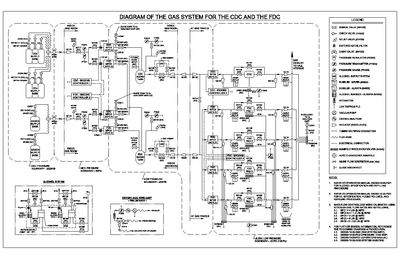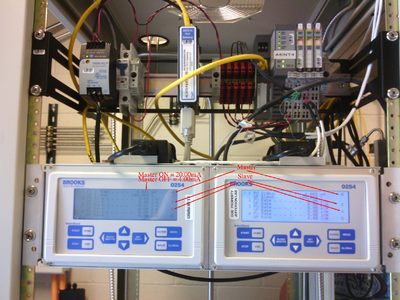Difference between revisions of "Gas System Shift"
(→Gas System for tracking chambers) |
(→Gas System for tracking chambers) |
||
| Line 3: | Line 3: | ||
[[Image:gassystem.png | thumb | 400px | Fig. 1. Gas system diagram for the FDC and CDC. ]] | [[Image:gassystem.png | thumb | 400px | Fig. 1. Gas system diagram for the FDC and CDC. ]] | ||
| + | [[Image:contrbox_gasshed.png | thumb | 400px | Fig. 2. Controller boxes for gas mixing for FDC (left) and CDC. ]] | ||
| − | The gas system provides the operating gas mixtures for the two tracking detectors FDC and CDC. The two detectors have to independent mixing stations to provide the appropriate gas mixture for the detectors. In case of the FDC this is a 40%/50% Argon/CO2 gas mixture while for the CDC it is a 50%/50% Argon/CO2 mixture. The gas is provided by high pressure (2500psi Argon, 800psi CO2) gas bottles located outside the gas shed (room 401 building 202). The gas pressure is regulated down to 50psi and directed into the gas shed. The gas mixing is done using a BROOKS mass flow controllers for each gas type. The gas is filled into a blending tank from which the gas is enriched with propyl alcohol before it is sent to the upper platform in the hall. The pressure in the blending tank is controlled by the PLC system and keept between 7 and 12 psi. From the blending tank the gas is going through the alcohol bubbler system that is located inside a refrigerator. The alcohol bubbler in the glass tube should always | + | [[Image:alcoholbubbler.png | thumb | 400px | Fig. 3. Alcohol bubbler system for FDC (bottom) and CDC. ]] |
| + | |||
| + | |||
| + | The gas system provides the operating gas mixtures for the two tracking detectors FDC and CDC. The two detectors have to independent mixing stations to provide the appropriate gas mixture for the detectors. In case of the FDC this is a 40%/50% Argon/CO2 gas mixture while for the CDC it is a 50%/50% Argon/CO2 mixture. The gas is provided by high pressure (2500psi Argon, 800psi CO2) gas bottles located outside the gas shed (room 401 building 202). The gas pressure is regulated down to 50psi and directed into the gas shed. The gas mixing is done using a BROOKS mass flow controllers for each gas type. The gas is filled into a blending tank from which the gas is enriched with propyl alcohol before it is sent to the upper platform in the hall. The pressure in the blending tank is controlled by the PLC system and keept between 7 and 12 psi. From the blending tank the gas is going through the alcohol bubbler system that is located inside a refrigerator. The alcohol bubbler in the glass tube should always bubbling and the level of alcohol should be between the two indicator lines (see figure 3) drawn on the glass. The level of alcohol in the glass bubbler should be recorded once per shift and the expert on call should be notified if refilling is required. The blending operation is operational if the letters "M" and "S" on the display (see figure 2) of the two mass flow controller boxes are blinking. | ||
The gas is distributed to the FDC and CDC through mass flow controllers located on the gas panel on the upper platform in the hall. Mineral oil bubblers on the upstream end of the detector (should never bubble) protect the detector from over pressure while the bubblers at the detector exhaust (should always bubble) protect the chambers from back flow. | The gas is distributed to the FDC and CDC through mass flow controllers located on the gas panel on the upper platform in the hall. Mineral oil bubblers on the upstream end of the detector (should never bubble) protect the detector from over pressure while the bubblers at the detector exhaust (should always bubble) protect the chambers from back flow. | ||
| − | |||
== Gas System Expert == | == Gas System Expert == | ||
Revision as of 15:16, 4 June 2014
Gas System for tracking chambers
The gas system provides the operating gas mixtures for the two tracking detectors FDC and CDC. The two detectors have to independent mixing stations to provide the appropriate gas mixture for the detectors. In case of the FDC this is a 40%/50% Argon/CO2 gas mixture while for the CDC it is a 50%/50% Argon/CO2 mixture. The gas is provided by high pressure (2500psi Argon, 800psi CO2) gas bottles located outside the gas shed (room 401 building 202). The gas pressure is regulated down to 50psi and directed into the gas shed. The gas mixing is done using a BROOKS mass flow controllers for each gas type. The gas is filled into a blending tank from which the gas is enriched with propyl alcohol before it is sent to the upper platform in the hall. The pressure in the blending tank is controlled by the PLC system and keept between 7 and 12 psi. From the blending tank the gas is going through the alcohol bubbler system that is located inside a refrigerator. The alcohol bubbler in the glass tube should always bubbling and the level of alcohol should be between the two indicator lines (see figure 3) drawn on the glass. The level of alcohol in the glass bubbler should be recorded once per shift and the expert on call should be notified if refilling is required. The blending operation is operational if the letters "M" and "S" on the display (see figure 2) of the two mass flow controller boxes are blinking.
The gas is distributed to the FDC and CDC through mass flow controllers located on the gas panel on the upper platform in the hall. Mineral oil bubblers on the upstream end of the detector (should never bubble) protect the detector from over pressure while the bubblers at the detector exhaust (should always bubble) protect the chambers from back flow.
Gas System Expert
| Name | Extension | Date of qualification |
|---|---|---|
| ON CALL Expert | xxx-xxxx | June 4, 2014 |
| Benedikt Zihlmann | 269-5310 | June 4, 2014 |
| Lubomir Pentchev | 269-5470 | June 4, 2014 |
| Scot Spiegel | xxx-xxxx | June 4, 2014 |


